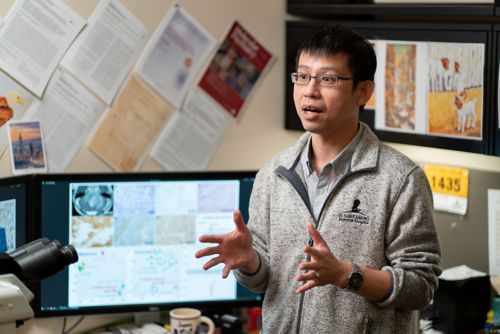St. Jude Family of Websites
Explore our cutting edge research, world-class patient care, career opportunities and more.
St. Jude Children's Research Hospital Home

- Fundraising
St. Jude Family of Websites
Explore our cutting edge research, world-class patient care, career opportunities and more.
St. Jude Children's Research Hospital Home

- Fundraising
Tracing the threads of metastasis to achieve better treatment outcomes

Understanding metastatic cancer offers a high potential to improve survival rates.
When it comes to cancer treatment, early diagnosis is always better for the patient. But why? When cancers are diagnosed before they have spread, the odds of successful treatment are greater. Once it has started to spread, a process called metastasis, the disease becomes much more challenging to treat and is associated with significantly higher mortality rates.
While in the clinic, metastatic spread is a dreaded state, but in the laboratory, researchers can look at unraveling the mysteries of metastasis as an opportunity to dramatically make a difference in patients’ lives across cancer types. This is particularly true for pediatric malignancies.
“We clinicians all know that a small percentage of these kids, who initially come in looking like their tumors are localized, will eventually develop metastatic disease,” said Lindsay Talbot, MD, St. Jude Department of Surgery. “It feels terrible — awful — when we find a metastatic spot. As soon as we see that, we know the five-year survival rate goes from over 80% to less than 30%, depending on the tumor type.”
Talbot is a surgeon at St. Jude, specializing in pediatric osteosarcomas. Osteosarcomas can be removed by surgery, with a good response rate. Even with this effective surgery, oncologists will give systemic chemotherapy to attempt to prevent any small, undetected metastatic sites from taking root.
“We don’t know which patients will have a metastatic tumor,” Talbot said. “We still can’t necessarily predict which patient will finish therapy and subsequently be at risk for metastasis. We have crude indicators such as how well the primary tumor responded to chemotherapy or whether the particular tumor has genetic alterations more associated with metastasis, but these predictions are very limited.”

Lindsay Talbot, MD, St. Jude Department of Surgery
The root of the lack of understanding of pediatric cancer metastasis is in a surprising place: its rarity. Thankfully, pediatric cancer is rare. Furthermore, depending on the cancer type, metastasis only impacts approximately 20% of these patients. Therefore, the number of metastatic samples to study is incredibly small. In addition, metastatic samples can be difficult to collect. Even for surgeons such as Talbot, metastatic sites are often too small, too widespread or in areas that make physical collection impractical.
Bringing innovations against metastatic disease into the clinic
Despite scant data and small sample sizes, St. Jude has found better ways to treat metastatic disease.
“PARP inhibitors for metastatic or recurrent tumors are one of the best examples of success here,” Talbot said. PARP inhibitors are a class of chemotherapy drug already known to be effective in some adult metastatic cancers, leading the investigators to believe they could also be effective in pediatric metastatic cancers, but that needed to be shown as adult and childhood cancers differ drastically on a biological level.
“Elizabeth Stewart, [MD, St. Jude Department of Oncology] used multiple patient xenografts in mice and treated them systematically with pharmacologically appropriate doses,” Talbot continued. “The PARP inhibitors showed distinct survival advantages, and that systematic evaluation has led to successful clinical trials.”
Taking samples from patients and placing them into a living model system for laboratory research, as Stewart did, extends each sample’s utility. The basic concept is so powerful that St. Jude now makes these models available to the scientific community. The St. Jude Childhood Solid Tumor Network’s mandate shares these orthotopic patient-derived xenografts with other researchers to accelerate discovery in the solid tumor space, including metastatic samples.
Another promising result in tackling metastatic disease is an ongoing clinical trial harnessing the immune system’s power. Chimeric antigen receptor (CAR) T–cell therapy is an immunotherapy that is growing in clinical importance. St. Jude is leading an ongoing clinical trial for CAR T cells targeting the cancer-related checkpoint protein B7-H3. Because T cells can freely move between tissues and will kill any cell expressing the cancer-related protein, the hope is that they will clear out metastatic sites, too, as has been the case in preclinical models.
Even with promising results in these specific cases, most metastatic disease still largely evades prediction and effective treatment. Solid tumors have often failed to respond to CAR T–cell therapy, and PARP inhibitors only work on a subset of cancers. The problem lies in the complexity of cancer itself, let alone cancers that metastasize.
“A mutation that gives rise to one cancer cell,” Talbot explained, “literally generates an entire evolutionary tree that’s just as complicated as the evolutionary tree of mammalian life on Earth. But we still need to find a way to understand the basic biology of cancer cells, especially those that metastasize, to be able to predict that problem and intervene earlier.”
The scientific challenge of metastatic disease
“Most simply, metastasis is the spread of cancer cells from the primary tumor to distant organs,” said Myriam Labelle, PhD, St. Jude Department of Oncology, who is at the cutting edge of researching the fundamental biology of metastatic disease.

Myriam Labelle, PhD, St. Jude Department of Oncology
“Treatment of primary tumors has been more successful in large part because of surgery. With metastases, some surgery can be done if they are caught very early, but once they become widespread, surgery is no longer an option,” Labelle continued, echoing Talbot.
For metastatic disease, there are no good conventional treatment options. Targeted radiation treatments suffer a similar problem as surgery. While whole-body radiation is an option, the side effects and late effects after treatment are severe, with no guarantee all metastatic sites will respond. The seemingly practical solution is to administer chemotherapy systemically, an approach which also has drawbacks.
“Metastases are likely resistant to the treatments that the patient received before,” Labelle said. “We are caught in the problem that the metastases will have the same resistance as the original tumor. Since metastases can be in different organs simultaneously, with different interactions between the tumor and the local tissue, you could potentially need to use multiple treatments to address the different affected organs.”
While tackling metastasis may seem daunting, St. Jude scientists such as Labelle are working to understand it on the biological level — so that it can be stopped or prevented.
Solving metastatic mysteries in the lab
If scientists can understand what makes metastatic cells more likely to thrive in new locations and avoid the body’s sensing mechanisms, they can begin to design interventions to prevent successful metastasis.
“I use the analogy that traveling is more challenging than staying home. Many tumor cells that start the journey will not successfully make it. So, metastasis to some extent is, luckily, very inefficient,” Labelle said.
Rather than considering metastasis a rare occurrence, Labelle views it as a common process where many tumors can shed cancer cells frequently. What is rare is for a cancer cell to succeed at seeding and growing into another location. The real threat is from the success of the few.
Labelle explained, “After seeding into distant sites, these tumor cells must interact and adapt well to their new environment. If we return to the analogy of traveling to a foreign country, many of these cells arrive in a new tissue but can’t speak the local language. Only those that speak or learn the language can thrive in their new location. This very, very small fraction will eventually give rise to a metastasis.”
When a metastatic cancer cell arrives in a new tissue, it must overcome a host of hurdles. Patrolling immune cells will kill the cell if detected. The local tissue’s cells may also impede the invasion of cancer cells. The cancer cells must gain the support of their new neighbors to thrive at the metastatic site, what is commonly called the tumor microenvironment.
“My lab focuses on these environmental signaling aspects, particularly the interaction of cancer cells with platelets during seeding,” Labelle said. “We have demonstrated that depleting platelets or blocking their communication with cancer cells almost completely blocks metastasis in animal models.”
Labelle’s work demonstrated that tumor cells migrating in the bloodstream can get lodged in small blood vessels and capillaries of distant organs. A platelet clot forms around the cancer cells, which the body sees as an injury, activating the wound repair response. The platelets then release copious signaling molecules. One of the signaling factors released by platelets is transforming growth factor-beta (TGF-β), which Labelle found to be key for the capacity of tumor cells to migrate and metastasize efficiently. When platelets are unavailable or lack TGF-β, these tumor cells fail to establish themselves into metastases.
Unfortunately, depleting all platelets is not a viable option in humans, as they are required for hemostasis and wound healing. However, there may be potential in targeting signaling factors secreted by platelets in combination with immunotherapy or chemotherapy, but that will require further feasibility research. Such problems highlight the intricate nature of treating metastasis.
Metastasis is complex and not all metastases are equal
Complicating the field, researchers have continued to look for interactions between healthy cells and metastasis, but the process is so complex that there can be conflicting results. Neutrophils, a type of early innate immune cell, have been shown to be important for both preventing and enhancing metastasis. Metastatic cells from different primary tumor types, or even similar ones that migrate to the same organ in different individuals, may behave differently, and distinct approaches may, therefore, be required to stop them.
“Not all metastases are equal,” Labelle emphasized. “Some are more intolerant than others. Some nodules become very big quickly, while others are slow. Some of the metastases can be cleared naturally, and others, unfortunately, will spread out. I think more and more people realize that there are multiple mechanisms of metastasis and diverse timelines, which can even vary within the same type of cancer. By understanding the fundamental mechanisms underlying these differences, we can move this field forward and identify effective anti-metastatic therapies.”
Brain metastasis: A unique environment
One example of a unique type of metastasis is when it occurs in the brain. Metastatic cells from tumors are always challenging to deal with, particularly anywhere in the central nervous system.
“When we talk about metastasis from a brain tumor,” said Jason Chiang, MD, PhD, St. Jude Department of Pathology, who specializes in brain malignancies, “the tumor originates from a specific location in your central nervous system, and the cancer cells shed into the cerebrospinal fluid, seeding in the leptomeninges, which is the vascular space surrounding and nourishing the brain.”

Jason Chiang, MD, PhD, St. Jude Department of Pathology
This ease of seeding has multiple consequences for brain tumors. Unlike breast or lung cancer in the body’s periphery, brain tumors do not need to reach an advanced stage to metastasize. Some brain tumor types are already metastatic at the time of diagnosis. One example, diffuse leptomeningeal glioneuronal tumors, includes the word “diffuse” because patients present with many nodules outside the primary tumor site at initial diagnosis. Other types, such as medulloblastoma and pineoblastoma, have a documented history of commonly metastasizing, which increases the need for surveillance and aggressive treatment.
“Even though patients may only have localized disease in the pineal gland or cerebellum, the standard of care is to radiate your entire brain ventricle and spinal cord to decrease the chance of metastatic disease,” Chiang said. “Radiating an entire central nervous system has a lot of side effects for the brain and the vertebral column as the bone will stop growing. There’s a lot of issues, especially in pediatric brain tumors.”
Younger patients are more susceptible to poor late effects of brain radiation. They have decreased cognitive function and delayed neurocognitive development compared to their peers. Being treated at this unique time in their lives has drastic consequences. In an ideal world, oncologists would know which tumors would likely metastasize and limit radiation doses to neural tissue, thus preventing late effects.
But to personalize treatments in this manner, researchers must first understand the differences between where metastatic cells come from, where they travel to and how long it takes to develop new nodules.
Metastatic diseases in the brain differ by origin and destination
“Where tumors come from is also as important as where they go,” Chiang said. “Some tumors metastasize early; some tumors metastasize late. The specific cell of origin at the specific place in the brain matters because the brain is a very specialized organ, unlike the liver or colon, which look pretty much the same other than that they’re in different places.”
“For example, your cortex functions very differently from your hypothalamus, from your pons and from your spinal cord,” Chiang explained. “All of the cells are different; their relative composition is different, and, developmental-wise, they’re different — factors which all impact metastatic disease.”
The difference in disease from different points of origin is both a challenge and an opportunity. Chiang’s lab showed that hypothalamic pilocytic astrocytoma, one particular type of brain tumor, has different prognoses even when they appear to be physically from the same area. About half of the tumors responded to radiation and chemotherapy, then just stopped growing — even if they weren’t fully resected. The other half metastasized, some of which caused mortality.
“We found molecular drivers and differences in signaling pathways,” Chiang said. “These cells were different from the very beginning. Although they are classified as the same tumor type, they have different biology. We found different signaling pathways: MAPK, mTOR, activation of the mitochondria — that’s energy production — and activation of the ribosome — upregulated to make the tumors behave more aggressively in the ones that metastasized. Therefore, the tumors that will metastasize, and those that do not, really should be considered different diseases, although they are in the same ballpark.”
Chiang’s group finding shows that the differences between potentially metastatic and non-metastatic disease can be found; it is just difficult and nuanced, especially in the central nervous system.
Similar to the work of the Childhood Solid Tumor Network, Chiang, in collaboration with Suzanne Baker, PhD, St. Jude Brain Tumor Research Division director and Neurobiology and Brain Tumor Program co-leader, created a resource to create models of brain disease. They also allow other scientists to request these models to enable their brain tumor research. Brain tumor samples are removed from patients to make an initial diagnosis. After that, the sample is usually discarded or frozen away. Instead, the St. Jude Pediatric Brain Tumor Portal collects that sample to create cell lines and animal models to study basic biology and attempt novel interventions.
Metastasis: finding the common threads to unravel
The complexity of metastatic cancer is unparalleled. Both where metastatic cells originate from and where they migrate affect the ability to take root, as well as when the cells shed in the tumor’s life cycle. An osteosarcoma in the bone marrow looks different from a neuroblastoma in the brain, but both have dismal prognoses if they metastasize. St. Jude scientists and physicians are pushing the field forward despite the difficulties in studying and treating metastatic disease.
“Even with all of this heterogeneity,” Labelle said. “There are key things that the tumor cells need to do to metastasize: every metastatic cell requires invading, migrating and surviving in the new tissue. If we target these processes, we can stop the cancer cells in the circulation or block their outgrowth from small metastases. Our fundamental research in these areas is promising and hopefully will bring treatments forward.”






